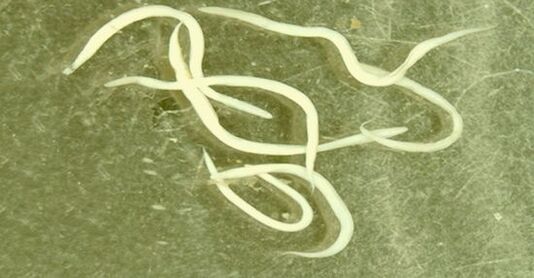
Many would be shocked if they learned that a person always lives "not alone. " In himself, as well as in his body, microorganisms are always present, and without this mutually beneficial cohabitation, a person will be severely ill and unable to survive. So, on the surface of healthy skin, there is a normal microflora that protects it from the reproduction of harmful microbes. In the vagina in women, there are lactobacilli, or Dederlein stems, which form a normal acidic environment. Finally, in the large intestines and feces of healthy people, there are hundreds of billions of microorganisms involved in the digestion of food, the production of vitamins, and the protection of a person from disease.
But,except microbes, all other random organisms - protozoa, and even worms - are parasites. . . Some begin to multiply, "poisoning" our bodies. How to detect parasites in the human body?

This question is far from idle. Of course, if the doctor points his finger and tells what parasites live in a particular person's body, then this patient will immediately undergo an examination. The same would happen if, for example, small worms were accidentally found in fresh feces. The question is clear: helminthic invasion is obvious. All that remains is to clarify the diagnosis and begin treatment.
But parasites have learned to "keep their noses out", and often their presence in the body causes incomprehensible changes that the sick person does not associate with the presence of parasites at all. What are these symptoms? How can one suspect, for example, chronic helminthiasis?
Common parasitic signs
All types of parasitosis, ranging from accidental (temporary), and ending with parasites that live in the human body continuously, are indicated by several symptoms. They can be divided into two groups:
- specific(characteristic of parasitic types), for example, swelling and muscle pain with trichinosis, development of acute appendicitis when crawling into the ascaris appendix, or unusual itching in the perianal region in the presence of cream worms.
But it is good if there are such symptoms that accurately indicate the cause of the invasion (in medicine it is called pathognomonic). But how to determine the presence of parasites in the human body if there are no such direct signs?
To do this, check if there are other symptoms that are common to parasitosis - not specific.
- not specificsymptoms are signs that indicate poisoning of the body with worm waste and protozoa.
In turn, these symptoms most often appear in the form of two syndromes:
- allergic reactions of the body to parasites;
- intoxication syndrome, or poisoning.
How to identify parasites in the human body, and what symptoms cause them?
The most common symptoms of parasitosis
- gradual, but continuous weight loss, not associated with chronic stress, increased levels of physical activity;
- the onset of insomnia. It can be caused by itching of the skin and the release of toxins, for example, during larval migration. In this case, the person only experiences a decline in well -being in the evening and night.
- the appearance of nausea and vomiting, sometimes due to rejection of food;
- anorexia, or a marked decrease in appetite, up to and including its complete absence. For example, with giardiasis, children often do not like to eat breakfast;
- there are weaknesses, weaknesses, declining performance;
- daytime drowsiness appears;
- temperature rises to subfebrile numbers (37. 1-37. 5);
- there is cephalgic syndrome: headaches appear unrelated to physical and mental stress.

The allergic manifestations of helminthiasis can be different. Urticaria may occur, skin itching for no reason may appear and disappear, allergic Quincke's edema, bronchospasm may occur.
If such,if you or your loved one is experiencing the above symptoms, see a doctor. . .
Of course, this does not limit the range of symptoms, but these are the most common.
About laboratory signs
How to identify parasites in the human body using simple tests? For example, while reviewing general blood test results, the following findings indicate helminthic invasion:
- anemia, or decreased hemoglobin levels and color index;
- eosinophilia. . . Typically, the number of eosinophils does not exceed 5%, and the number increases with parasitic diseases.
Of course, you can not undergo all the tests in sequence, the doctor knows better what to prescribe in each particular case.
About accidental discoveries
Sometimes unintentional discoveries can help identify the presence of parasites in the human body. How does this happen?
- for example, with fluorography, there is unusual darkness in the lung field, which may turn into a parasitic cyst;
- during a brain MRI, it is also possible to detect one or more cysts, often asymptomatic.
In conclusion, it must be said thatafter the detection of these symptoms, a specific diagnosis is made: immune reaction is established, stool is analyzed, if necessary, the contents of the duodenum are taken. Of course, life history is very important. Therefore, if a person the day before rests in hot Asian and African countries, and swimming in places is not recommended, or uses dubious quality water, or unwashed fruit, then the presence of helminthic invasion is greater than likely.

In the same way, if a child has similar symptoms after school, kindergarten, and parents are convinced that the cause is not a stressful situation due to the influence of an organized team, then there is more than enough reason to visit a pediatrician infectious disease specialist.
Treatment of identified helminthiasis is performed in a special helminthology (parasitology) room, which is usually located in each regional center in a major infectious disease hospital.



























